When it comes to the power adapter, many people may not know what it is. If you say that the rectangular accessory on the laptop charging line or the mobile phone charger is common, yes, that is the power adapter, and the power adapter is another It is called an external power supply, which is a power supply voltage conversion device for small portable electronic equipment and electronic appliances. It is commonly used in small electronic products such as mobile phones, liquid crystal displays and notebook computers.
Their function is to convert the high voltage of 220 volts in the home into a stable low voltage of about 5 volts to 20 volts that these electronic products can work, so that they can work normally. It is composed of components such as boards, and its working principle is converted from AC input to DC output (Abbreviation:AC TO DC); according to the connection method, it can be divided into wall adapters and desktop adapters. Using them can make our lives less inconvenient.
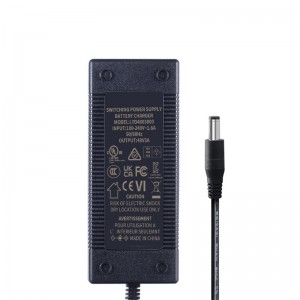
1.What is the difference between a power adapter and a charger?
Before introducing the difference between a charger and a power adapter, let's first introduce what a charger is and what a power adapter is. A charger usually refers to a device that converts alternating current into low-voltage direct current. It includes current limiting, voltage limiting and other control circuits that meet the charging characteristics. The power adapter is a power converter that is transformed, rectified and regulated. The output is DC, which can be understood as a power supply with stable voltage when the power is satisfied.
PacoliPower power adapter manufacturers will analysis with you : power adapter and charger
Phone charger:
Phone charger usually refers to a device that converts alternating current into low-voltage direct current. It includes control circuits such as current limiting and voltage limiting that meet the charging characteristics. Chargers are widely used in various fields, especially in the field of life, they are widely used in common electrical appliances such as mobile phones and cameras. It generally charges the battery directly without going through any intermediary equipment and devices. The process of the charger is: constant current - constant voltage - trickle, three-stage intelligent charging. The three-stage charging theory in the charging process can greatly improve the charging efficiency of the battery, shorten the charging time, and effectively prolong the battery life. The three-stage charging adopts constant current charging first, then constant voltage charging, and finally uses float charging for maintenance charging.
Power adapter:
Power adapter supply usually refers to a device that converts alternating current into low-voltage direct current. It includes control circuits such as current limiting and voltage limiting that meet the charging characteristics. Chargers are widely used in various fields, especially in the field of life, they are widely used in common electrical appliances such as mobile phones and cameras. Most power adapters can automatically detect 100-240V AC (50/60Hz). The power adapter is a power supply conversion device for small portable electronic devices and electronic appliances. It externally connects the power supply to the host with a line, which can reduce the size and weight of the host. Only a few devices and electrical appliances have built-in power in the host. Inside. It is composed of a power transformer and a rectifier circuit inside, and can be divided into AC output type and DC output type according to its output type; according to the connection method, it can be divided into wall-mounted and desktop. There is a nameplate on the power adapter, which indicates the power, input and output voltage and current, etc., pay special attention to the range of the input voltage.
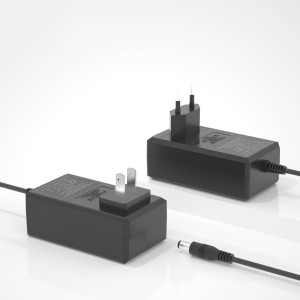
2.Power Adapter Precautions
There are generally several items that need attention on the label of the power adapter (hereinafter referred to as the adapter).
1. It is the INPUT (input) of the adapter, which is generally 100-240V~50-60Hz in China, which means that the adapter can work normally under the voltage of 100V-240V;
2. It is the OUTPUT (output) of the adapter. Two numbers can quickly calculate the wattage of the adapter. For example, in this adapter, the voltage is 12V*current 1A=12W (power), indicating that the power supply is a 12W adapter. Most laptop power adapters are suitable for 100-240V AC (50/60Hz). Basically, most laptops have an external power supply and use a power cord to connect with the host, which can reduce the size and weight of the host. Only a few models have the power supply built into the host.
3. There is a nameplate on the power adapter, which indicates the power, input and output voltage and current, etc., pay special attention to the range of the input voltage, this is the so-called "travel power adapter", if the mains voltage is only 110V This feature is very useful when you are in other countries. Some parallel notebook computers are only sold in the country of origin, without this compatible voltage design, and even only have a single input voltage of 110V, and they will burn when they are plugged in under the 220V mains voltage.
3.Composition and application of power adapter
Power adapters are commonly found on small electronic products such as cell phones, LCD monitors, and notebook computers. It is generally composed of a casing, a power transformer and a rectifier circuit. According to its output type, it can be divided into AC output type and DC output type; according to the connection method, it can be divided into wall-mounted and desktop.
Common collocations:
12v 0.5a power adapter,12v 1a power adapter,12v 1.5a power adapter,12v 2a power adapter(Desktop and wall-mounted are more common,It is suitable for telephone sub-machines, game consoles, language repeaters, Walkmans, notebook computers, cellular phones and other equipment.)
12v 20a power adapter(10a-20a),12v 7a power adapter(5a-10a)·······(If more than 5A, there are few wall-plug power adapters, most of them are desktop type, generally suitable for: large audio, large medical equipment, advertising machines, heating pads, aerators·····)
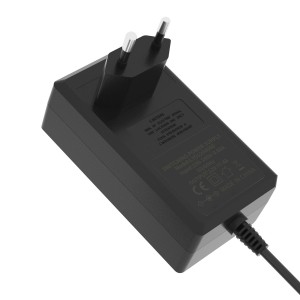
Wall-Mounted power adapter
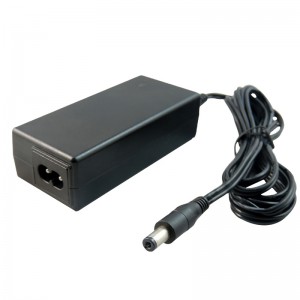
Desktop Power adapter
4.Types of power adapters
There are two main types of power adapters, switching power supplies and linear power supplies.
1. The switching power supply is a power supply that uses modern electronic technology to control the time ratio of switching on and off to maintain a stable output voltage. The switching power supply of the power adapter is generally composed of a pulse width modulation (PWM) control IC and a MOSFET.
Advantages: high working efficiency, small size, can work in a wide voltage range.
Disadvantages: The interference to the power supply circuit is large, and the maintenance is difficult when a fault occurs.
2. The linear power supply transforms the AC power through the transformer, and rectifies and filters the rectifier circuit to obtain an unstable DC voltage. To achieve a high-precision DC voltage, the power adapter must adjust the output voltage through a voltage feedback circuit.
Advantages: The power supply technology is mature, the circuit is simple, and there is no interference and noise of the switching power supply.
Disadvantages: The voltage feedback circuit works in a linear state, the power consumption of the regulating tube is large, the conversion efficiency is low, and the equipment is heavy due to the use of an inductive transformer.
Foshan Pacoli Power Co., Ltd. can convert the high voltage 100-240V into the voltage 3-120VDC required by the customer according to the needs of the customer, and the customer can choose.
5.What material is the power adapter?
Next, pacoli will introduce the material differences of the power adapter shell to you. You can learn more about this kind of relevant information and avoid some potential safety hazards to a great extent! Generally, the shell of power adapter is made of plastic material. Of course, some industrial power supplies use metal shell. The materials of our common power adapter shell mainly include ABS material, ABS + PC material and pure PC material. Generally, we only use these three materials. Let's introduce the differences of these materials one by one.
PC material
Pure PC material has ultra-high strength and elastic coefficient, and is suitable for a wide temperature range (ABS general material can only be used at -25 degrees to 60 degrees), and PC material has high transparency and free dyeing, so for It is very good for the power adapter to be made in various colors. In addition, this material also has fatigue resistance, weather resistance, tasteless and odorless, and is harmless to the human body, which is in line with hygiene and safety.
ABS material
ABS material features, first of all, low strength and temperature resistance. Under normal circumstances, the maximum operating temperature cannot exceed 60 degrees Celsius, which is much worse than PC material. ABS is generally used in household appliances.
Synthetic material of ABS and PC
Taking the characteristics of the former two, it has excellent molding performance, good fluidity and high strength. ABS+PC material is easy to process, has good processing dimensional stability and surface gloss, easy to paint, color, and can also perform secondary processing properties such as metal spraying, electroplating, welding and bonding. Because the characteristics of ABS combine the characteristics of its three components, it has excellent comprehensive performance, and it has become one of the preferred plastics for electrical components, home appliances, computers and instruments.
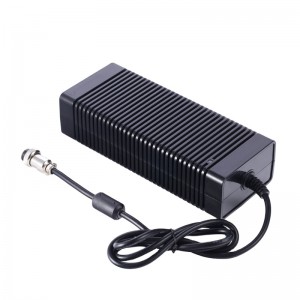
12v 20a 240w ac dc power adapter
6.Common faults and troubleshooting methods
1. Line failure Line failure, including damage to the power line, no power supply, poor oxidation of the contact port, etc. Focus on checking whether the input line and output line are powered on. If the line is faulty, it can be solved by replacing the power cord.
2. The output voltage is too low The following are the main reasons for the low output voltage:
1) The load of the switching power supply is short-circuited (especially the DC/DC converter is short-circuited or has poor performance, etc.), at this time, first disconnect all the loads of the switching power supply circuit, and check whether the switching power supply circuit is faulty or the load circuit is faulty. If the load circuit is disconnected and the voltage output is normal, it means that the load is too heavy; or if it is still abnormal, the switching power supply circuit is faulty.
2) The failure of the filter capacitor or rectifier diode at the output voltage end can be judged by the replacement method.
3) The performance of the switch tube is degraded, which causes the switch tube to fail to conduct normally, which increases the internal resistance of the power supply and reduces the load capacity.
4) The poor switching transformer will not only cause the output voltage to drop, but also cause insufficient excitation of the switch tube, which will damage the switch tube.
3, the output voltage is too high The output voltage is too high generally from the voltage regulator sampling and voltage regulator control circuit. In the closed control loop formed by the DC output, sampling resistor, error sampling amplifier such as TL431, optocoupler, power control chip and other circuits, any problem in any of these parts will cause the output voltage to rise.
4. The fuse is normal, no output voltage The fuse is normal, and no output voltage indicates that the switching power supply is not working or has entered a protection state. The first step is to check the value of the start-up voltage of the start-up pin of the power control chip. If there is no start-up voltage or the start-up voltage is too low, check whether the external components of the start-up pin and the start-up resistor are leaking. If the power control chip is normal, the fault can be quickly found through the above monitoring. If there is a start-up voltage, measure whether the output terminal of the control chip has jumps of high and low levels at the moment of power-on. If there is no jump, it means that the control chip is damaged, the peripheral oscillation circuit components are damaged or the protection circuit is faulty, and the control chip is replaced by replacement. Chip, check peripheral components, check one by one; if it is jumping, in most cases, the switch tube is bad or damaged.
5. The fuse is burned out or blown up. Mainly check the rectifier bridge, each diode, switch tube and the large filter capacitor on 300 volts. It may cause the fuse to burn and become black, or it may be caused by a problem with the anti-jamming circuit. It is especially worth noting that the fuse is burned due to the breakdown of the switch tube, which usually burns out the power control chip and the current detection resistor. The thermistor is also easy to burn out along with the fuse.
For more information please contact: jef@pacolipower.com
Post time: Apr-19-2022





